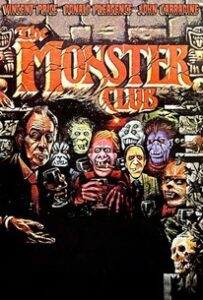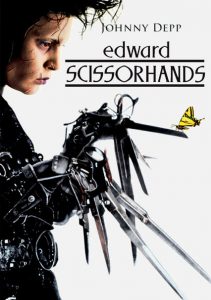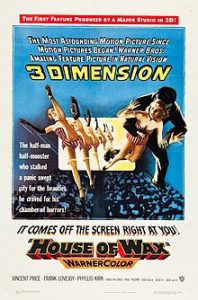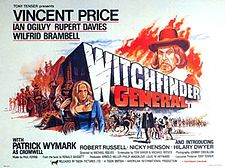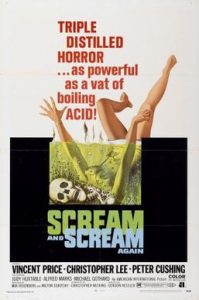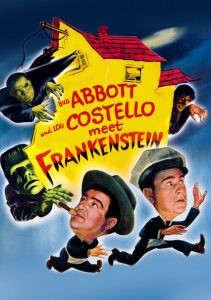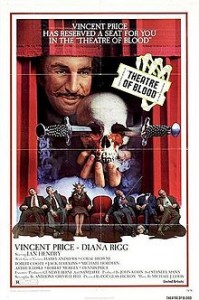The Monster Club-1981
Director Roy Ward Baker
Starring Vincent Price, Donald Pleasence, John Carradine
Scott’s Review #1,378
Reviewed July 16, 2023
Grade: B
Any horror feast including Vincent Price and Donald Pleasence is worth a watch and The Monster Club (1981) features both actors though not in any scenes together.
The British horror anthology is uneven and a tad too silly with only two of the three chapters recommended. They are based on the works of the British horror author R. Chetwynd-Hayes.
The graphics and art direction are surprisingly superior for such a low-budget production.
In between chapters, there is a jarring and unnecessary musical performance by one of the creatures. While sort of fun, it takes away from the continuity and feels thrown in rather than serving any real purpose.
Below is a summary, review, and rating of each vignette.
Prologue: B
Author R. Chetwynd-Hayes (John Carradine) is approached on a city street by a strange man (Vincent Price) who turns out to be a starving vampire named Eramus.
He bites the writer and takes the confused man to an odd club. It’s a haven for supernatural creatures as they dance, drink, and carry on together.
Eramus introduces three stories about his fellow creatures of the night.
This chapter is relevant to tie the chapters together and any scene involving Price is good in my book. It also serves as a learning experience to explain the different types of creatures but little more.
The Shadmock: A-
Angela (Barbara Kellerman) is a financially struggling woman who takes a job at a secluded mansion owned by Raven (James Laurenson), a creature called a Shadmock.
Along with her greedy boyfriend (Simon Ward), they hatch a plot to steal Raven’s great wealth after he proposes to Angela. When she is caught unlocking Raven’s safe his demonic whistle comes into play at the expense of Angela and her boyfriend.
This chapter has a great setup and an unrequited love vibe. With a Beauty and the Beast comparison, the audience sympathizes with Raven. All he wants is love and the ultimate climax is heartbreaking with the knowledge that he is being duped.
I longed for Angela to come to her senses, dump her boyfriend, and be carried away by Raven but it’s horror after all, and not romance.
Starting slowly, the grotesquely exquisite gothic mansion and the fine luxuries contained are fun to feast one’s eyes on and the sinister conclusion is not to be missed.
The Vampires: B-
A shy young boy (Warren Saire) from a kind family of vampires lives a lonely life where he is bullied at school and his father (Richard Johnson) spends little time with him.
The father is hunted by a team of vampire killers led by Pickering (Donald Pleasance) who attempt to drive a stake through the father and kill him. But the tables are soon turned.
This chapter is cute but uninspired adding more humor than horror to the mix. Pleasance isn’t given a great role and neither is former ‘Bond girl’ Britt Eklund as the supportive mother.
It pales sharply against ‘The Shadmock’ and ‘The Ghouls.
The Ghouls: A
A movie director (Stuart Whitman) scouting locations for his next film pays a visit to an isolated village, Loughville, where the sinister residents refuse to let him leave.
While imprisoned by the ghouls, he meets Luna (Lesley Dunlop), the daughter of a ghoul father (Patrick Magee) who agrees to help him escape. But can Luna or the resident police be trusted?
The Ghouls is my favorite because it feels the most unpredictable and I love the early shots of a movie production studio. The ghostly-looking creatures are appealing because there is an ambiguity about their motives and the secrets beheld in the village.
It’s also fun balancing the sophisticated style of the movie producer against the drudgery of the villagers. Also, the inclusion of actor Magee from A Clockwork Orange (1971) is a win.
Epilogue: B
At the end of the film, Eramus cheerfully tells the other club members all the imaginative ways that humans have of being horrible to each other and declares that humans are the most despicable monsters of all.
Thus Chetwynd-Hayes is made an honorary monster and member of the club.
The quick chapter is a clever wrap-up to the story and culminates as a bit of a ‘message’ about kindness and humanity.
